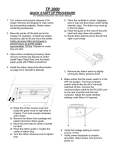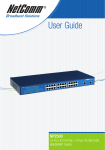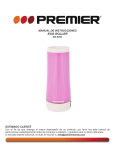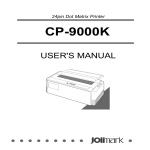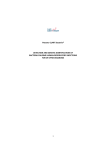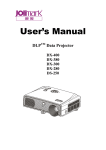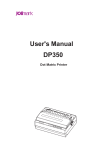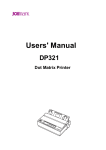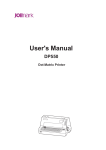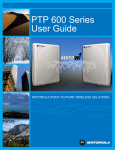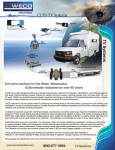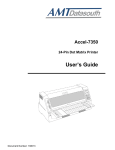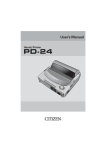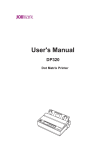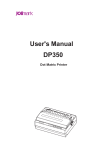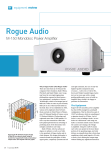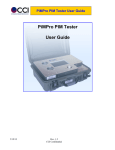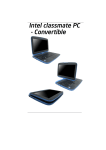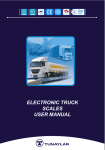Download Jolimark FP-8800K User`s Manual V.1.02
Transcript
24-pin Dot-matrix Printer FP-8800K USER’S MANUAL JOLIMARK® FP-8800K 1 2 3 4 No part of this manual may be reproduced in any form. This manual is subject to change without notice. This manual was prepared with the greatest care. If you should find any unclear points, mistakes, or omissions, please contact us. We will not bear any responsibility for unsatisfactory results from the use of this printer despite item 3 above. * EPSON is a registered trademark of Seiko Epson Corporation. * LQ-2550 is a registered trademark of Seiko Epson Corporation. * IBM is a registered trademark of International Business Machines Corporation. * IBM 2391 is a registered trademark of International Business Machines Corporation. * Windows is a registered trademark of Microsoft Corporation. FP-8800K USER’S MANUAL KongYue Electronics & Information Industry (XinHui) Ltd. Caution.............................................................................................................................. i Chapter 1 Setting up the printer ................................................................................. 1-1 •Unpacking the printer.......................................................................................... 1-1 • Connecting the printer to the power source .................................................... 1-2 • Connecting the printer to the computer ........................................................... 1-2 1. Parallel interface ........................................................................................ 1-2 2. Serial interface ........................................................................................... 1-2 • Installing the ribbon cassette ............................................................................ 1-3 • Setting up the Rear tractor mode ...................................................................... 1-4 • Setting up the Manual mode .............................................................................. 1-9 • Setting up the Front tractor mode ................................................................... 1-12 ・ Setting up the CSF(option) mode................................................................... 1-16 • Installing the printer driver .............................................................................. 1-21 Chapter 2 Control panel operation ............................................................................. 2-1 • Control panel....................................................................................................... 2-1 1. Control panel view ..................................................................................... 2-1 2. Function keys............................................................................................. 2-2 3. LCD ............................................................................................................. 2-5 • Paper path lever........................................................................................... 2-6 • Head adjustment lever ................................................................................ 2-7 • Key shortcut functions................................................................................ 2-7 Chapter 3 Setup options.............................................................................................. 3-1 • How to use the setup modes ............................................................................. 3-1 1. Keys used for setting ................................................................................ 3-1 2. Setting example ......................................................................................... 3-2 Chapter 4 How to use SETUP Memory ....................................................................... 4-1 • How to use SETUP Memory ............................................................................... 4-1 Chapter 5 Troubleshooting ......................................................................................... 5-1 • How to solve the problem .................................................................................. 5-1 1. Printing speed is slow. .............................................................................. 5-1 2. Printing is light........................................................................................... 5-1 3. Paper jam often occurs. ............................................................................ 5-1 4. SKEW ERROR. ........................................................................................... 5-1 5. PAPER JAM. ............................................................................................... 5-2 6. Paper sensor. ............................................................................................. 5-2 7. Out-of-paper can not be detected............................................................. 5-2 8. Not straight in vertical line printing.......................................................... 5-2 9. Incorrect characters printed. .................................................................... 5-2 10. Unexpected printing results.................................................................... 5-3 11. Factory default settings........................................................................... 5-3 • How to solve the error message........................................................................ 5-4 1. Functional error message ......................................................................... 5-4 2. Operational error message ....................................................................... 5-5 Chapter 6 Specifications ............................................................................................. 6-1 • Printer specifications ......................................................................................... 6-1 • Other specifications ........................................................................................... 6-2 • Paper specifications ........................................................................................... 6-2 • Options&Consumable ........................................................................................ 6-2 Safety Cautions z Do not touch the print head immediately after printing because it is too hot. z Do not put your finger under the tractor cover while loading fanfold paper. Safety Cautions z Use two hands and hold firmly at each end when lifting the cut sheet feeder. Personal injury can occur if the CSF unit is dropped. z Do not put your finger on the tractor gear, when using the rear tractor. Cautions in setting up z Unpack the printer. Make sure that the printer body and all accessories are included in the package and no parts are damaged. z Do not sue the printer in a location exposed to direct sunlight or close to a heater or other heat generating equipment. z Do not use the printer in a dusty location or any location subject to sudden changes in temperature and humidity. z Place the printer on a rigid, horizontal base in a location that is free of vibration. z Before connecting or disconnecting the interface cable, be sure to turn off the printer. z Do not connect the printer to a non-standard power source. z If any foreign matter gets into the printer, turn off the printer immediately and remove the foreign matter. z If the case or cover becomes dirty, clean it with a soft cloth moistened with a small quantity of neutral detergent diluted with water. Never use a hard cloth or volatile solvent such as alcohol, thinner, or benzine. z Take care not to twist the ribbon while installing the ribbon cassette. Cautions in setting up z Never try to print without a ribbon cassette installed and paper loaded. z Push the lock levers of both tractors to the LOCK positions firmly while loading fanfold paper or single sheet paper. It is for the purpose of setting paper path securely. z i Do not turn off the printer during printing, as this may lead to a malfunction. Chapter 1 Setting up the printer •Unpacking the printer FP-8800K OWNER’S MANUAL OWNER’S MANUAL *Remove lever, fixed on the bottom side of Paper rack. The packing style is subject to change without notice. Chapter 1 Setting up the printer 1- 1 Chapter 1 Setting up the printer • Connecting the printer to the power source • Make sure that the power switch is set to off. Connect the printer with the supplied power cord to an AC outlet Once the printer is turned off, wait for three seconds or more before turning it on again. If the printer is turned on again within three seconds after turning it off, it may malfunction due to an initialization failure. Note Caution • The AC outlet shall be installed near the printer and shall be easily accessible. Connect the AC power plug to an AC outlet of the voltage designated on the rating plate on the back of the printer • Connecting the printer to the computer 1. Parallel interface Make sure that the power switch is turned to off. Connect the signal cable to the printer and the computer. 2. Serial interface Make sure that the power switch is turned to off. Connect the signal cable to the printer and the computer. 1 - 2 Chapter 1 Setting up the printer Chapter 1 Setting up the printer • Installing the ribbon cassette 1. Turn off the power. Open the front cover. Move the print head to the left end position. Caution Do not touch the print head immediately after printing because it may be too hot. 2. Remove the Red Fixing Material located at the center of the ribbon cassette, attach the cassette, as shown below. Chapter 1 Setting up the printer 1- 3 Chapter 1 Setting up the printer 3. Fit the holes in the ribbon attachment to the right and left projections on the print head. • Make sure that the ribbon is properly under the edge of the print head. 4. Turn the ribbon feed knob counterclockwise to remove any slack in the ribbon. • Setting up the Rear tractor mode 1 - 4 Chapter 1 Setting up the printer Chapter 1 Setting up the printer • Tractor can be installed in front or rear side; Front tractor or Rear tractor, called in the hand book. 1. Attach the paper rack holders (right / left) to the printer as shown below. Press the holders until you hear click. When removing the paper rack holder, use the remove lever, screwed on the paper rack. See the instruction on the rear side of the paper rack. 2. Attach the paper rack to the paper rack holders. 3. Put the paper rack down. Press the paper rack on the paper rack holders. Chapter 1 Setting up the printer 1- 5 Chapter 1 Setting up the printer 4. Move the both paper guides to the right / left end. 5. Connect the connector on the left side of tractor to the connector on the rear side of the printer. Then install the rear tractor. 6. The both tractors can be moved right and left to meet the width of paper or printing data when the lock lever is released. CAUTION Do not put your finger under the tractor cover • Set fanfold paper onto the tractors. 1 - 6 Chapter 1 Setting up the printer Chapter 1 Setting up the printer 7. Slide the paper path lever to the symbol or the position of "AUTO". The lever position should be at "AUTO" when using the printer driver. 8. Specify the page length. Fanfold paper size marked on package (Example) Specify the page length referring the number of sprocket holes on the paper in case that the paper length can not be specified. No. of holes x 0.5 inch equals to the page length. The 8 of holes on the above mean that this fanfold is 4 inches in length. Chapter 1 Setting up the printer 1- 7 Chapter 1 Setting up the printer 9. Perform the trial printing after connecting the printer to the computer. Adjust the tractors to find a correct position in case that the printing is tilted to right / left. In case of tilting vertically the printing start position should be adjusted by “4 TOF ADJUST”. 1 - 8 Chapter 1 Setting up the printer Chapter 1 Setting up the printer • Setting up the Manual mode 1. Attach the paper rack holders (right / left) and the paper rack. See the item No. 1-3 on the page 1-5. 2. Adjust the printing position by sliding the paper guide right or left. When loading a wide paper, adjust the right paper guide. Chapter 1 Setting up the printer 1- 9 Chapter 1 Setting up the printer 3. Slide the paper path lever to the symbol or the position of "AUTO". The lever position should be at "AUTO" when using the printer driver. 4. Connect the printer to the computer and perform a trial printing. The display appears as below along with the sound of buzzer when the printer receives the data from the computer. 1 - 10 Chapter 1 Setting up the printer Chapter 1 Setting up the printer 5. Insert a cut sheet paper straight along the paper guide. If a paper is inserted on the skew, the printer detects it. Then the printer adjusts the skew automatically for the certain skewed angle. If a paper is inserted on the skew as the upper left of the paper is over the paper guide, the printer may not adjust the skew. In this case, move the paper guide to the left a little, then insert the paper at some distance from the paper guide. Note In case of tilting vertically the printing position should be adjusted by “5 TOF ADJUST”. When printing a book, set BOOK at #40 MANUAL PAPER TYPE and the set the book size at #41 MANUAL BOOK SIZE. Chapter 1 Setting up the printer 1- 11 Chapter 1 Setting up the printer • Setting up the Front tractor mode 1. Attach the paper rack holders ( right / left ) to the printer as shown below. Press the holders until you hear click. 2. Connect the connector on the left side of tractor to the connector on the front side of the printer. 3. Attach the tractor to the paper rack holders as shown below. 1 - 12 Chapter 1 Setting up the printer Chapter 1 Setting up the printer 4. Attach the paper rack to the paper rack holders. 5. The both tractors can be moved right and left to meet the width of paper or printing data when the lock lever is released. • Set fanfold paper onto the tractors. Chapter 1 Setting up the printer 1- 13 Chapter 1 Setting up the printer 6. Put the paper rack down. Press the paper rack on the paper rack. 7. Slide the paper path lever to the symbol or the position of "AUTO". The lever position should be at "AUTO" when using the printer driver. 1 - 14 Chapter 1 Setting up the printer Chapter 1 Setting up the printer 8. Specify the page length. Setup mode Check the fanfold paper size marked on the package. 9. Perform the trial printing after connecting the printer to the computer. Adjust the tractors to find a correct position in case that the printing is tilted to right / left. In case of tilting vertically the printing start position should be adjusted by “3 TOF ADJUST”. When using the front tractor along with the CSF, cut the fanfold paper by hand, not by the paper cutter. Chapter 1 Setting up the printer 1- 15 Chapter 1 Setting up the printer ・ Setting up the CSF(option) mode 1. Attach the paper rack holder (right / left) and the paper rack. See the item No. 1-3 on the page 1-5. 2. Move the both paper guides to the right / left end. 3. Attach the hoppers and center support to the cut sheet feeder. 1 - 16 Chapter 1 Setting up the printer Chapter 1 Setting up the printer 4. Attach the cut sheet feeder to the back of the printer. CAUTION Use both hands and hold firmly at each end when lifting the cut sheet feeder. Personal injury can occur if the CSF unit is dropped. 5. Shuffle the paper as show below. Note Be sure to shuffle sheets sufficiently before setting them. Otherwise, several sheets of paper may be fed at the same time resulting in a paper jam. Chapter 1 Setting up the printer 1- 17 Chapter 1 Setting up the printer 6. Turn the CSF release levers to the front to release the paper bin. 7. Turn the paper guide lock lever to the Release position to adjust the paper width. Turn the paper guide lock lever to the Lock position. 1 - 18 Chapter 1 Setting up the printer Chapter 1 Setting up the printer 8. Move the CSF release levers to the back to fix the paper bin. 9. Slide the paper path lever to the symbol or the position of "AUTO". The lever position should be at "AUTO" when using the printer driver. Chapter 1 Setting up the printer 1- 19 Chapter 1 Setting up the printer 10. Perform the trial printing after connecting the printer to the computer. In case of tilting vertically the printing start position should be adjusted by “6 TOF ADJUST”. Remove the paper rack holder when storing the printer. 1 - 20 Chapter 1 Setting up the printer Chapter 1 Setting up the printer • Installing the printer driver For the details of the printer driver, see the User’s Manual in the packed Driver-CD. Chapter 1 Setting up the printer 1- 21 Chapter 2 Control panel operation • Control panel The liquid crystal display (LCD) on the control panel displays the processing conditions of the printer and the setting of the functions. The keys on the control panel provide various functions. 1. Control panel view Chapter 2 Control panel operation 2- 1 Chapter 2 Control panel operation 2. Function keys 1. ONLINE Press the ONLINE key to change the printing enabled (online) state and printing disabled (offline) state. 2. RESET (ALT + ONLINE keys) Press the ONLINE key for two seconds or more while you press the ALT key, a buzzer will sound. Then “INITIAL” is displayed on the LCD if the keys are released. The printer is reset immediately. 3. HIGH SPEED Press the HIGH SPEED key to display the currently selected printing quality on the LCD. Each press of the key to display the printing qualities in the following order. To select the displayed printing quality, press the ENTER key. 4. FORMAT Press the FORMAT key to change the setup memory. Each press of the FORMAT changes the setup memory as shown below. FORMAT 1 FORMAT 2 FORMAT 3 FORMAT 4 FORMAT 5 FORMAT 6 To select the displayed setup memory, press the ENTER key. 2 - 2 Chapter 2 Control panel operation Chapter 2 Control panel operation 5. SETUP (ALT + FORMAT keys) Press the SETUP key to enter the SETUP MODE. See the Chapter 3 Setup options for details. 6. ENTER The setting are fixed by pressing the ENTER key. Use for specifying the mode on the key HIGH SPEED, FORMAT and SETUP. 7. ALT The following functions are executed by pressing the corresponding key while you press the ALT key. LF/FF → MICRO LF RLF → MICRO RLF FORMAT → SETUP ONLINE → RESET 8. TEAR OFF Press the TEAR OFF key, and the printer automatically feeds the perforation of the paper to the paper cutter position (for fanfold paper only). If the perforation is not adjusted to the cutter position, correct the position with the MICRO LF or MICRO RLF key. The correct position is saved in memory, and the perforation is fed automatically to the paper cutter position at next time. When using the front tractor along with the CSF, cut the fanfold paper by hand, not by the paper cutter. Chapter 2 Control panel operation 2- 3 Chapter 2 Control panel operation 9. EJECT/LOAD ● ● ● ● If the EJECT/LOAD key is pressed when fanfold paper is loaded, the paper is fed back to the parking position. When it is pressed when a cut sheet paper is loaded, the paper is ejected. When the EJECT/LOAD key is pressed when fanfold paper is at the parking position, the paper is loaded to the TOF position. When the EJECT/LOAD key is pressed with no paper in the manual mode, the key is ignored. When it is pressed with paper loaded in the manual mode, the printer ejects the paper. When the EJECT/LOAD key is pressed with no paper in the CSF mode, the printer loads paper. When it is pressed with paper loaded in the CSF mode, the printer ejects the paper. 10. LF/FF Press the LF/FF key to feed the line in the forward direction at a pitch of 1/6 inch. Keep the key depressed to feed the page at the currently set page length. 11. MICRO LF (ALT + LF/FF keys) Press the MICRO LF key to feed the line in the forward direction at a pitch of 1/360 inch. Use this key to adjust the paper position. 12. RLF Press the RLF key to feed the line in the reverse direction at a pitch of 1/6 inch. Keep the key depressed for continuous reverse line feeding. 13. MICRO RLF (ALT + RLF keys) Press the MICRO RLF key to feed the line in the reverse direction at a pitch of 1/360 inch. Use this key to adjust the paper position. 2 - 4 Chapter 2 Control panel operation Chapter 2 Control panel operation 3. LCD Current paper path and the setup memory No. are displayed. Front tractor Manual Rear tractor CSF 4. Lamps ONLINE (Green) ON: Printing is enabled. OFF: Printing is disabled. Blinking: The cover is open, or the printer is in the head temperature protect mode. HIGH SPEED (Green) ON: High speed printing. OFF: Normal speed printing. ERROR (Amber) ON: No paper is detected or other operational error occurred. OFF: No error is detected. Blinking: A functional error has occurred(such as home sense error. Internal RAM error, paper path switching error. Head adjustment error, park error and skew error). DATA (Green) Blinking while date is transferred. Lights while date is processed or when the input buffer contains data .Goes out in other state. Chapter 2 Control panel operation 2- 5 Chapter 2 Control panel operation • Paper path lever The lever for changing the paper path. Position Paper path Front tractor Manual Rear tractor CSF The required paper path can be selected by the setting of the lever. The paper path command is valid when selecting the “AUTO”. The lever position should be at “AUTO” when using the printer driver. Before changing the paper path, remove the paper inside the printer by pressing the EJECT/LOAD key. 2 - 6 Chapter 2 Control panel operation Chapter 2 Control panel operation • Head adjustment lever This lever is for adjusting the gap between the print head and the paper. The lever position should be at "AUTO " normally, which adjusts the gap in accordance with the SETUP MODE. When " AUTO " is selected on the panel, the printer measures the paper thickness and adjusts the gap between the print head and the paper automatically. In case that the graduation 1 - 7 is selected, the gap between print head and paper is fixed. Best position can be selected manually to meet the paper thickness as follows; Graduation 1 for 1 sheet form. Graduation 7 for 7 sheets multipart form. • Key shortcut functions Key shortcut functions are executed by pressing and holding the corresponding keys while simultaneously turning on the printer power. The following table shows the available shortcut functions. Chapter 2 Control panel operation 2- 7 Chapter 3 Setup options • How to use the setup modes The printer has setup modes, i.e., function setting modes that are unique to this printer. The setup modes enable various printer functions to be set up with the function keys on the operation panel. This section provides an the outline of the setup modes and the details of the setup functions. For the details of the setup modes, see the User’s Manual in the packed Driver-CD. 1. Keys used for setting 1. Setup key Press the SETUP key to enter the SETUP MODE. 2. Menu selection keys These keys are used to change the displayed menus. They change only the display and do not change the setting. The menus is changed rapidly when the or key is depressed and held for a second or more. 3. Item selection keys These keys are used to change items displayed in a menu. They change only the display and do not change the setting. 4. ENTER key To select a displayed item, press the ENTER key. When the ENTER key is pressed, the selected item is marked with an asterisk (*), and the menu reappears. 5. FORMAT key Press the FORMAT key to exit the SETUP MODE. The setting is automatically stored in the memory of the printer, and the printer, is initialized. 3- 1 Chapter 3 Setup options Chapter 3 Setup options 2. Setting example The following is the example to change the page length of fanfold paper from 11 to 8 inch. 1. Press the SETUP key while depressing the ALT key. 2. Select #7 with the 3. Press the key. 4. Press the or or key. key to display "8 INCH" on the LCD. 5. Press the ENTER key. "8 INCH" is marked with on asterisk. 6. Press the FORMAT key. The setting is automatically saved and the printer is initialized. Chapter 3 Setup options 3 - 2 Chapter 3 Setup options •Function of the setup modes 3- 3 Chapter 3 Setup options Chapter 3 Setup options Chapter 3 Setup options 3 - 4 Chapter 4 How to use SETUP Memory • How to use SETUP Memory This printer has total 6 types of SETUP Memory 1 - 6. Various SETUP stated in the chapter 3 can be memorized in every memory. The memory type in current operation is normally indicated with the number on the LCD as shown below. Å Indicating that the printer is operated at the mode of MEMORY 1. The SETUP memory is changed by pushing the FORMAT key. If pushing the key first; The above display appears and the printer sets into the mode of MEMORY CHANGE. If pushing the FORMAT key each time, the memory numbers are changed as shown below. 1 Æ 2 Æ 3 Æ 4 Æ 5 Æ 6 The SETUP memory is specified by pushing the ENTER key. The printer is initialized automatically once the memory setting is changed. If the ENTER key is not pushed for 3 seconds, the message on the LCD returns to the normal display. When every SETUP memory is set, each SETUP should be changed by referring the chapter 3 after selecting the memory number. Chapter 4 How to use SETUP Memory 4- 1 Chapter 5 Troubleshooting • How to solve the problem 1. Printing speed is slow. Push the key HIGH SPEED and select the mode High-speed. 2. Printing is light. Check the condition of ribbon cassette. Æ If the surface of fabric becomes whitish, replace the cassette with a new one. Head Adjustment may not be adequate. Æ Adjust the setting of #2 HEAD ADJUSTMENT. When a multipart form are used for printing. Æ Select “DARK” at the setting of #1 MULTIPART. 3. Paper jam often occurs. Head Adjustment may not be adequate. Æ Adjust the setting of #2 HEAD ADJUSTMENT. The thickness of paper may not be certain. Æ Select “YES” at the setting of #16 LF STABILIZATION. 4. Cut sheet paper is ejected as SKEW ERROR, though paper is loaded straight manually. Check if the black printing is on paper. Æ Select “NO” at the setting of #36 PAPER SKEW DETECTION. Chapter 5 Troubleshooting 5- 1 Chapter 5 Troubleshooting 5. The message PAPER JAM appears, though paper is not jammed. The paper jam sensor may not function properly if the sensors on the tractors are exposed to a direct light or sunlight. Æ Adjust the position of the printer not to be exposed to an excessive light. Check if any dark printing is near the sprocket hole on the backside of fanfold paper or if any hole is on the paper fastener of the multipart paper. Æ Select “NO” at the setting of #37 PAPER JAM DETECTION in the SETUP mode. 6. The paper sensor does not detect paper. (The print start position of paper tilts downward) The detection capability of the sensors may not be adequate level. Æ Perform the EEPROM Initialization 2. ( See page 5 - 3 ) 7. Out-of-paper can not be detected. In case that the printing is continued even when the paper is out, the setting may not be adequate. Æ Make sure of the paper size, the page length on SETUP and the format of the printing data. The message "REMOVE PAPER" appears even when the paper is ejected, the detection capability of the sensors may not be adequate level. Æ Perform the EEPROM Initialization 2. ( See page 5 - 3 ) 8. Not straight in vertical line printing. Select “ BIDIRECTIONAL” at the setting of #50 PRINTING DIRECTION. 9. Incorrect characters printed. The connection with the PC may not be correct. Æ Check whether the cable connection is faulty or broken. 5 - 2 Chapter 5 Troubleshooting Chapter 5 Troubleshooting 10. Unexpected printing results. The gap occurs between the print start position and the top end of paper. Æ Adjust the gap by setting #3 - #6 TOF ADJUSTMENT in the SETUP mode. ( The setting on SETUP differs in accordance with each paper path.) The unexpected printing position occurs right and left. Æ Adjust the position moving the tractors or the paper guides right and left. #12 LEFT MARGIN in the SETUP mode is effective to adjust the position. The unexpected printing position occurs from the second page of fanfold paper. Æ The page length of fanfold paper is not correct. Set the paper length again using #7 and #8 PAGE LENGTH in the SETUP mode. The setting on the PC also need to be checked. The unexpected printing position occurs vertically after the Out-of-paper. Æ Select “ PAGE END” at setting of #35 PAPER OUT DETECTION. 11. Restore all the settings in the SETUP mode to the factory default settings. • EEPROM Initialization 1 Restore the settings in the SETUP mode to the factory default settings. [Procedure] Keep the FORMAT and LF/FF keys depressed and turn on the printer. The message is displayed on the LCD and returns to the normal display after the initialization 1. • EEPROM Initialization 2 The learning of the sensors switching position is performed. The settings in the SETUP mode are not changed. [Procedure] Set 15-inch fanfold paper to the rear tractors. Keep the HIGH SPEED and EJECT/LOAD keys depressed and turn on the printer. After confirming the paper setting, press the ENTER key. When the message is displayed, press the FORMAT key. The printer returns to the normal mode. Chapter 5 Troubleshooting 5- 3 Chapter 5 Troubleshooting • How to solve the error message 1. Functional error message The functional errors means that serious error that can not be recovered by the key operation. When a functional error occurs, turn the power off once and turn the printer on after removing paper inside the printer. If the message remains still after the above procedure, please contact the dealer. The printer has the 12 types of the functional errors 1 to 12. 5 - 4 Chapter 5 Troubleshooting Chapter 5 Troubleshooting 2. Operational error message • The print head is being cooled to prevent it from overheating. The ONLINE lamp blinks. The print head has become too high-density printing. When this displayed, the printing speed is printing stops. When the print head drops, the printer restarts printing. hot during message is reduced or temperature • This error message indicates that fanfold paper is not fed back to the packing position properly. Cut the paper to remove it. Fanfold paper is not set on the front tractor. Install fanfold paper on the front tractor and press the ONLINE key. Fanfold paper is not set on the rear tractor. Install fanfold paper on the rear tractor and press the ONLINE key. A cut sheet is not loaded into the printer. Put a cut sheet on the front rack and load it into the printer. A cut sheet is not set into the CSF. Install cut sheets into the CSF and press the ONLINE key. Chapter 5 Troubleshooting 5- 5 Chapter 5 Troubleshooting A paper jam occurs at the front tractor. Pull the ejected paper outward gently and press the ONLINE key to restart printing. When the PAPER JAM still remains, remove all paper and reinstall the paper into the tractor properly and press the ONLINE key. Re-adjust the gap between the print head and the paper, by #2 HEAD ADJUSTMENT. When the paper thickness may be not constant, set YES at #16 LF STABLE. When the PAPER JAM appears despite no actual paper jamming, set NO at #37 PAPER JAM DETECT.. A paper jam occurs at the rear tractor. See the above column of PAPER JAM FRONT TR for troubleshooting. Fanfold paper is not fed properly. Remove the paper and reinstall the paper into the tractor properly. A cut sheet is not ejected properly. Remove the paper manually. 5 - 6 Chapter 5 Troubleshooting Chapter 5 Troubleshooting • This error occurs if the printer detects that a cut sheet paper is loaded on the big skewed angle manually. The ERROR lamp blinks, and the buzzer sounds three times. The paper is ejected and the printer enters the offline state. Load paper again. If it is loaded straight, the printer enters the online state. • This error occurs if the front cover is opened. The ONLINE lamp blinks. Closing the front cover will remove the cause of this error. The printer is in the offline state while the cover is opened. CAUTION Never open the front cover during printing. Press the ONLINE key to stop printing and then open the front cover. • The jam sensor is defective when loading fanfold paper. Press the ONLINE key to recover the printer from this error. The paper jam detection function is disabled. Remove paper dust from the jam sensor, and load fanfold paper again. The paper jam sensor may not function properly when the sensor is exposed to a direct light or sunlight especially at using the rear tractor. Chapter 5 Troubleshooting 5- 7 Chapter 6 Specifications • Printer specifications Printing Method Print Head Maximum column Print speed Multipart printing Line feed speed Line feed pitch Paper path Serial impact dot matrix 24pin 136 columns (10cpi) LQ 150 CPS (10cpi) NLQ 200 CPS (10cpi) HQDR 300 CPS (10cpi) DRAFT 400 CPS (10cpi) SD 480 CPS (12cpi) SSD 600 CPS (15cpi) Standard 1+4p DARK 1+6p 36 LPI 1/360 INCH Front tractor or rear tractor Manual CSF (option) Head adjustment Interface AUTO, FIX Parallel, (bidirectional; IEEE 1284, nibble mode) Serial Input buffer Emulation 64 k byte EPSON LQ-2550 IBM 2391™ Other functions Barcode function Enlarged character Font typeface Setup memory 10 styles 6 memories Chapter 6 Troubleshooting 6- 1 Chapter 6 Specifications • Other specifications Power supply Power consumption Operating temperature Operating humidity Dimensions Weight • Paper specifications Available paper size • Fanfold paper AC 120 V, 60Hz (USA and Canada) AC 220-240V, 50-60Hz (Europe and Asia) Draft self 170watts 2.3A (120VAC) 1.3A(220-240VAC) Stand-by 40watts 0.6A (120VAC) 0.4A(220-240VAC) Energy Saving 15watts 5 to 40 (41 to 104 F) 20 to 80% (No condensation) 635mm(W) x 465mm(D) x 294mm(H) 22kg Paper width 203.2~381mm Paper thickness 0.08~0.12mm Paper weight 55~90kg Paper quality Wood-free paper • Fanfold paper multipart forms Paper width 203.2~381mm Number of sheet 7 or less Paper thickness 0.12~0.52mm Paper weight 34kg 1+6 Paper quality non-carbon equivalent • Cut sheet paper Manual mode Paper width 182~430mm Paper length 182~430mm Paper thickness 0.08~0.12mm Paper weight 55~90kg Paper quality Wood-free paper • Cut sheet paper multipart forms mode Paper width 182~430mm Paper length 182~430mm Number of sheet 7 or less Paper thickness 0.12~0.52mm Paper weight 34kg 1+6 Paper quality non-carbon equivalent • Card, Manual mode Paper width 182~430mm Paper length 182~430mm Paper thickness 0.08~2.0mm • Book, Manual mode Book size A4, A5, A6 and 140 x 105mm thickness Max 1.3mm * Some paper may not be used for the special paper constitute and quality. • Options & Consumable • CSF • Ribbon cassette Chapter 6 Troubleshooting 6- 2
















































